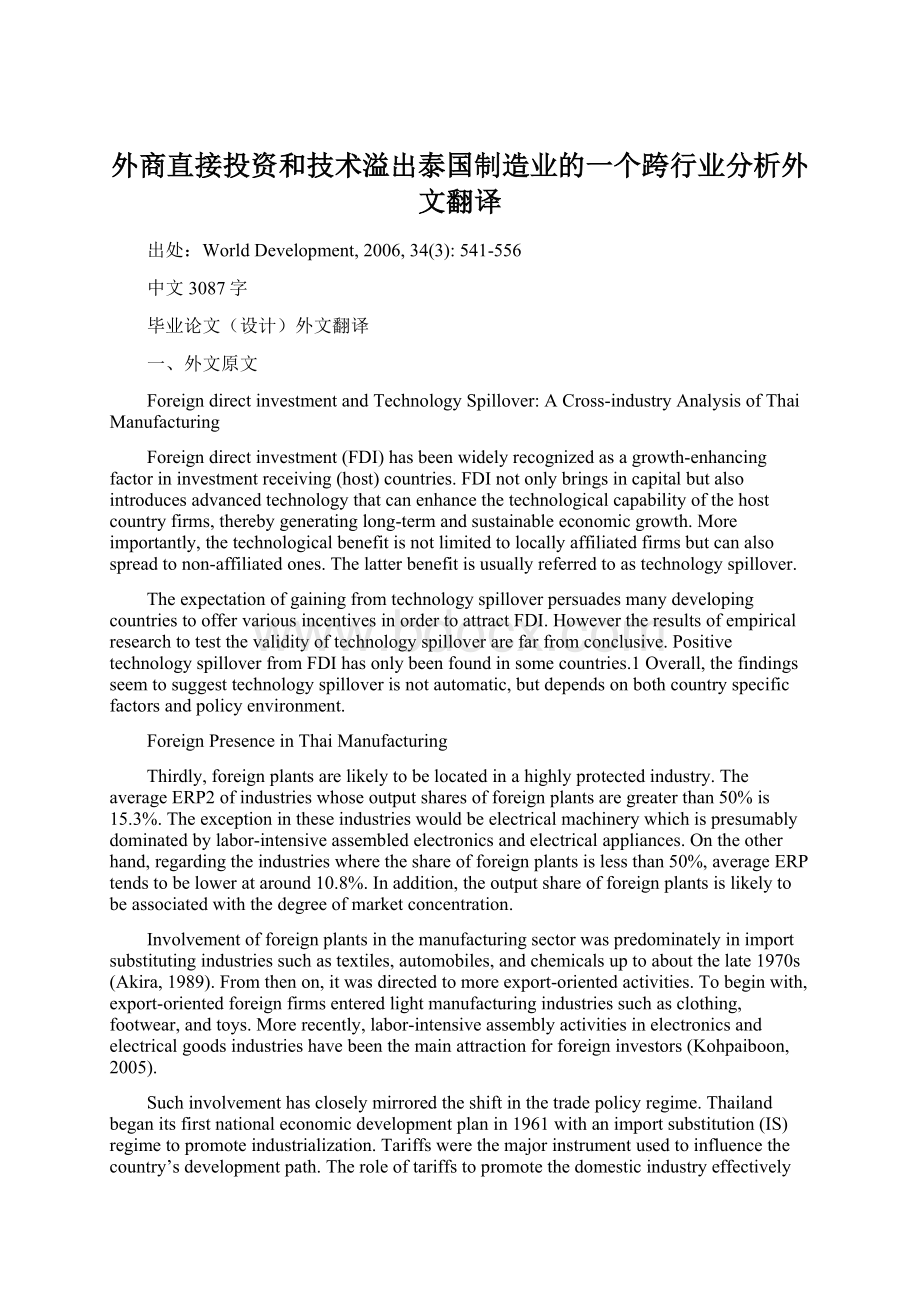外商直接投资和技术溢出泰国制造业的一个跨行业分析外文翻译文档格式.docx
《外商直接投资和技术溢出泰国制造业的一个跨行业分析外文翻译文档格式.docx》由会员分享,可在线阅读,更多相关《外商直接投资和技术溢出泰国制造业的一个跨行业分析外文翻译文档格式.docx(6页珍藏版)》请在冰豆网上搜索。

外商直接投资和技术溢出泰国制造业的一个跨行业分析外文翻译@#@出处:
@#@WorldDevelopment,2006,34(3):
@#@541-556@#@中文3087字@#@毕业论文(设计)外文翻译@#@一、外文原文@#@ForeigndirectinvestmentandTechnologySpillover:
@#@ACross-industryAnalysisofThaiManufacturing@#@Foreigndirectinvestment(FDI)hasbeenwidelyrecognizedasagrowth-enhancingfactorininvestmentreceiving(host)countries.FDInotonlybringsincapitalbutalsointroducesadvancedtechnologythatcanenhancethetechnologicalcapabilityofthehostcountryfirms,therebygeneratinglong-termandsustainableeconomicgrowth.Moreimportantly,thetechnologicalbenefitisnotlimitedtolocallyaffiliatedfirmsbutcanalsospreadtonon-affiliatedones.Thelatterbenefitisusuallyreferredtoastechnologyspillover.@#@TheexpectationofgainingfromtechnologyspilloverpersuadesmanydevelopingcountriestooffervariousincentivesinordertoattractFDI.Howevertheresultsofempiricalresearchtotestthevalidityoftechnologyspilloverarefarfromconclusive.PositivetechnologyspilloverfromFDIhasonlybeenfoundinsomecountries.1Overall,thefindingsseemtosuggesttechnologyspilloverisnotautomatic,butdependsonbothcountryspecificfactorsandpolicyenvironment.@#@ForeignPresenceinThaiManufacturing@#@Thirdly,foreignplantsarelikelytobelocatedinahighlyprotectedindustry.TheaverageERP2ofindustrieswhoseoutputsharesofforeignplantsaregreaterthan50%is15.3%.Theexceptionintheseindustrieswouldbeelectricalmachinerywhichispresumablydominatedbylabor-intensiveassembledelectronicsandelectricalappliances.Ontheotherhand,regardingtheindustrieswheretheshareofforeignplantsislessthan50%,averageERPtendstobelowerataround10.8%.Inaddition,theoutputshareofforeignplantsislikelytobeassociatedwiththedegreeofmarketconcentration.@#@Involvementofforeignplantsinthemanufacturingsectorwaspredominatelyinimportsubstitutingindustriessuchastextiles,automobiles,andchemicalsuptoaboutthelate1970s(Akira,1989).Fromthenon,itwasdirectedtomoreexport-orientedactivities.Tobeginwith,export-orientedforeignfirmsenteredlightmanufacturingindustriessuchasclothing,footwear,andtoys.Morerecently,labor-intensiveassemblyactivitiesinelectronicsandelectricalgoodsindustrieshavebeenthemainattractionforforeigninvestors(Kohpaiboon,2005).@#@Suchinvolvementhascloselymirroredtheshiftinthetradepolicyregime.Thailandbeganitsfirstnationaleconomicdevelopmentplanin1961withanimportsubstitution(IS)regimetopromoteindustrialization.Tariffswerethemajorinstrumentusedtoinfluencethecountry’sdevelopmentpath.Theroleoftariffstopromotethedomesticindustryeffectivelybeganin1974withtheimpositionofanescalatingtariffstructure,wherethetariffrateascendedfromrawmaterialstofinishedproducts.Thesechangesincreasinglyfavoredtheproductionoffinishedproducts,particularlyconsumerproducts.In1975,therangeoftheeffectiverateofprotection(ERP)intheThaimanufacturingsectorwasbetween–36to350%(Akrasanee&@#@Ajanant,1986).In1982,thevariationwidenedfrom–25.2to1,693.4%(Chunanantathumetal.1984).Severalindustries,suchastextiles,tyres,furniture,automobiles,andleatherproducts,hadanextremelyhighERP.TherewasalsoahighdegreeofvariationinERPacrossindustries.Thistariffstructureremainedvirtuallyunchangeduntilthelate1980s,eventhoughin1974thegovernmentannouncedachangeindevelopmentstrategytoanexportpromotion(EP)regime.@#@Significanttariffreductionscommencedin1988,startingwithelectricalandelectronicgoodsaswellaswiththeinputsintotheseproducts.Comprehensivepackagesoftariffreformwereimplementedin1995and1997.Itinvolvedtariffreductionandrationalization.Maximumtariffswerereducedfrom100%intheearly1990sto30%.Bytheendofthe1990s,thetariffbandswerereducedfrom39to6tariffrates(0,1,5,10,20and30%).Thetwolowrates(0and1%)wereforrawmaterialsandthetwotoprates(20and30%)forfinishedproductswiththetwomiddleratesforintermediategoods.Inaddition,tariffrestructuringhasreceivedrenewedemphasisasanessentialpartoftheoveralleconomicreformsaimedatstrengtheningefficiencyandcompetitivenessoverthepasttwoyears.TheThaigovernmentintroducedanotherefforttolowertariffrates,commencinginJune2003(implementedinOctober2003),followedbyafouryearperiodoftariffreductionfrom2004to2008.Therearearound900itemsinvolvedinthesecondroundoftariffreductions,coveringawiderangeofmanufacturingproducts.Thetariffreductioninthisroundismainlyonintermediateproducts,therebymaintainingtheescalatingtariffstructure.Themagnitudeoftariffreductionismoderate,withintherangeof0to8.9%(Athukoralaetal.2004).@#@Asaresult,averaget